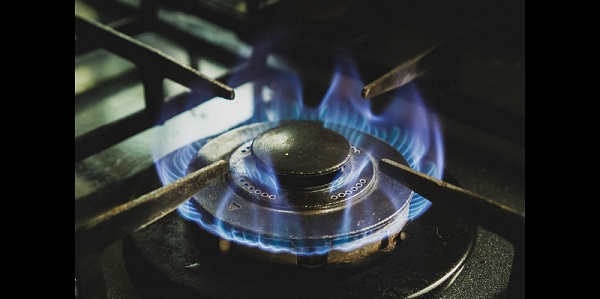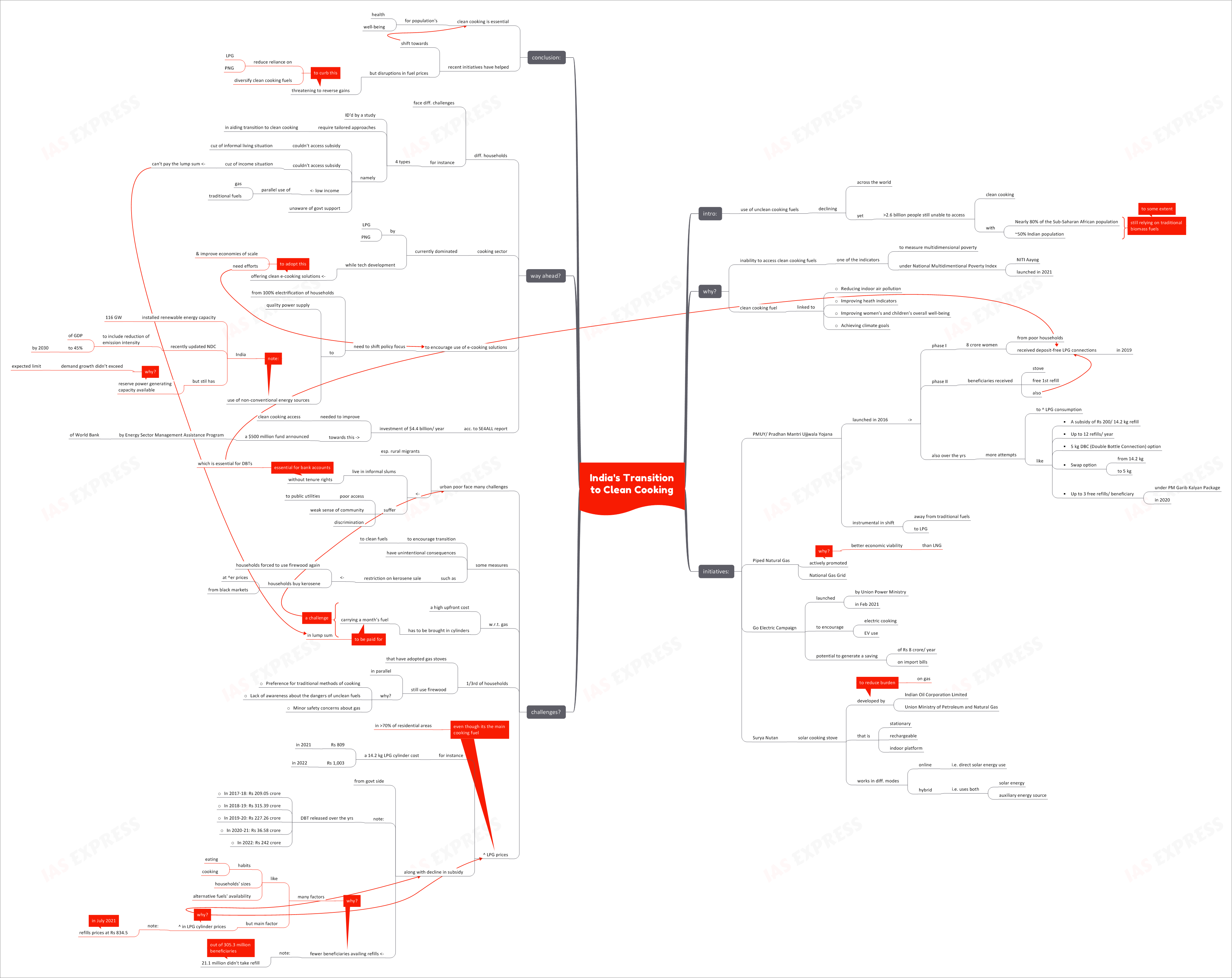[Editorials] India’s Transition to Clean Cooking

Across the world, the use of unclean cooking fuels has been declining. However, more than 2.6 billion people are still unable to access clean cooking. Nearly 80% of the Sub-Saharan African population rely on traditional biomass fuels. In India too, the dependence (to some extent) is still close to 50%.
This topic of “[Editorials] India’s Transition to Clean Cooking” is important from the perspective of the UPSC IAS Examination, which falls under General Studies Portion.
Why is clean cooking fuel essential?
- Inability to access clean cooking fuels is one of the indicators to measure multidimensional poverty under NITI Aayog’s National Multidimentional Poverty Index, launched in 2021.
- Clean cooking fuel is linked to:
- Reducing indoor air pollution
- Improving heath indicators
- Improving women’s and children’s overall well-being
- Achieving climate goals
What are some government interventions?
- PMUY/ Pradhan Mantri Ujjwala Yojana:
- This scheme, launched in 2016, has been instrumental in increasing the shift from traditional fuels to LPG.
- Under PMUY phase I, 8 crore women from poor households received deposit-free LPG connections in 2019.
- Under PMUY phase II, the beneficiaries received a stove and free first refill, in addition to depositing free LPG connections.
- Over the years, several attempts have been made to increase LPG consumption under this scheme, including
- A subsidy of Rs 200/ 14.2 kg refill
- Up to 12 refills/ year
- 5 kg DBC (Double Bottle Connection) option
- Swap option from 14.2 kg to 5 kg
- Up to 3 free refills/ beneficiary under PM Garib Kalyan Package in 2020
- Piped Natural Gas
- PNG is being actively promoted by the government given its higher economic viability than LNG.
- The under-construction National Gas Grid is an example.
- Go Electric Campaign
- This campaign was launched by the Union Power Ministry in February 2021 to encourage electric cooking and also EVs.
- It has the potential to generate a saving of Rs 8 crore/ year on import bills.
- Surya Nutan
- It is a solar cooking stove developed by IOCL (Indian Oil Corporation Limited) and the Union Ministry of Petroleum and Natural Gas.
- This stationary, rechargeable indoor cooking platform was launched in June 2022 to reduce the burden on gas.
- It works in different modes, making it a reliable solution irrespective of the weather:
- Online i.e. directly uses solar energy
- Hybrid i.e. uses both- solar energy and an auxiliary energy source
What are the challenges?
- Urban poor, mostly rural migrants coming in search of work, often reside in informal slums without any tenure rights. Such rights are essential for opening bank accounts, which in turn are needed for DBTs to work.
- They also suffer poor access to public utilities along with a weak sense of community and entrenched discrimination.
- Some measures like restriction on kerosene sale, intended to encourage the transition to clean cooking, have unintentionally pushed some households back to using firewood. Other households are now having to pay higher rates for kerosene on the black market.
- When it comes to gas, there is a high upfront cost and has to be brought in cylinders carrying a month’s fuel paid for in a lump sum. This is a challenge for the poor.
- Of those households that have adopted gas stoves, 1/3rd still use firewood as well. The reasons being:
- Preference for traditional methods of cooking
- Lack of awareness about the dangers of unclean fuels
- Minor safety concerns about gas
- While LPG is the main fuel source in over 70% of the residential areas, its cost has been spiking- a 14.2 kg LPG cylinder cost Rs 809 in 2021, but rose to Rs 1,003 in 2022.
- Even as the LPG prices increased, the government reduced the subsidy for it. For instance, subsidy released via DBT over the years:
- In 2017-18: Rs 209.05 crore
- In 2018-19: Rs 315.39 crore
- In 2019-20: Rs 227.26 crore
- In 2020-21: Rs 36.58 crore
- In 2022: Rs 242 crore
- This is leading to decreasing number of beneficiaries availing refills. 21.1 million of the total 305.3 million beneficiaries didn’t take any refill in 2021-22. While many factors, like eating and cooking habits, household sizes and alternative cooking fuels’ availability also contribute to LPG consumption trends, the biggest reason is the high price of LPG cylinders, with refills under PMUY being priced at Rs 834.5 in July 2021.
What is the way ahead?
- Studies have identified that different households are facing different obstacles in the transition towards clean cooking. For instance, a study identified 4 types of households, each requiring approaches tailored to their specific needs:
- Households that couldn’t access subsidy because of their informal living situation
- Those that couldn’t access subsidy because of their inability to save for the lump sum payment, given the income situation
- Low income households that use gas and traditional methods in parallel
- Those unaware of the government support they were eligible for
- Currently, the cooking sector is dominated by LPG and PNG, while there have been technological developments offering clean e-cooking solutions. Efforts are needed to improve the economies of scale and the adoption of such solutions.
- To encourage the adoption of e-cooking solutions, the policy focus should shift from 100% electrification of households to quality power supply and use of non-conventional energy sources.
- India has an installed renewable energy capacity of 116 GW. The country recently updated its Nationally Determined Commitments to include reduction of emission intensity of its GDP to 45% by 2030. In spite of this, India still has reserve power generating capacity available as the demand growth didn’t exceed the expected limit.
- According to a report by SE4ALL (an international initiative that advocates for achieving the UN SDGs), an investment of $4.4 billion/ year is required to improve clean cooking access. Towards this end, World Bank’s Energy Sector Management Assistance Program has announced a $500 million fund to aid transition to clean cooking.
Conclusion:
Clean cooking is essential for the health and well-being of the population. While the recent initiatives have aided the shift away from traditional unclean fuels, the recent disruptions in fuel prices is threatening to reverse the gains. Reducing the reliance on only LPG and PNG and diversification of clean cooking fuels could help sustain the gains.
Practice Question for Mains:
What are the government initiatives for the transition to clean cooking? What are the impediments to this transition? Suggest some solutions (250 words)


